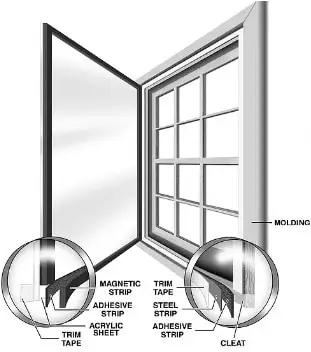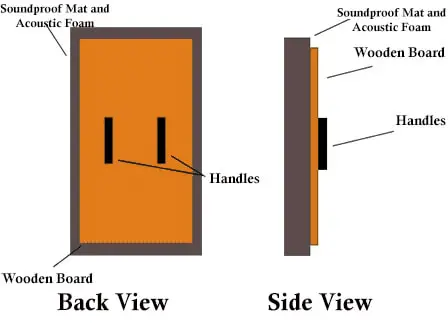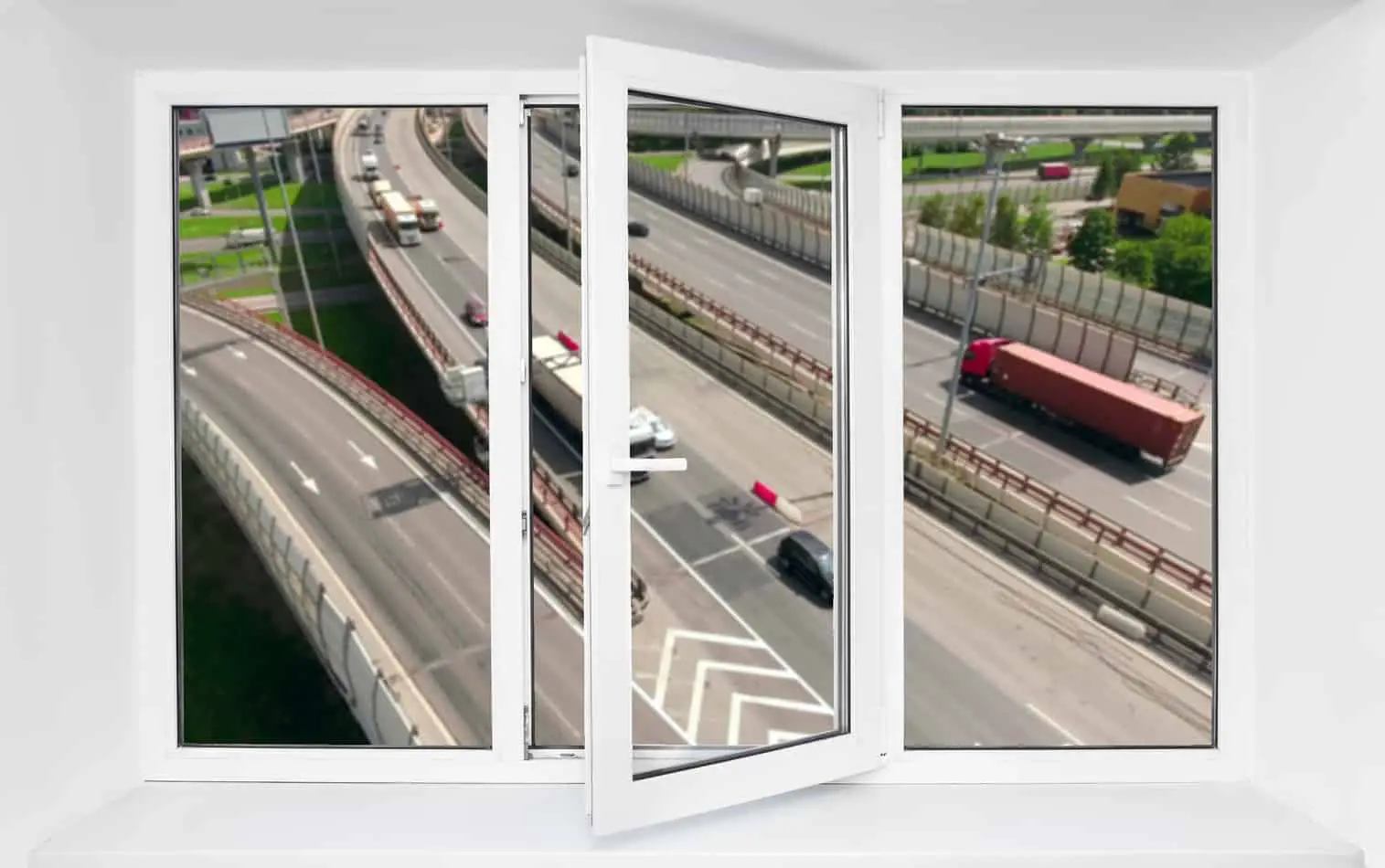Not all windows are created equal. Older homes or apartments may have an issue with sound leaking through windows.
Most of the time, it is because of a bad or nonexistent seal on a window that lets excessive noise through.
I happen to live right next to the main freeway, and my window sucks at keeping the noise out.
Even though there is a huge wall blocking the freeway, it isn’t enough to stop all the noise from traveling over the wall and into my living room.
I’ve read through countless articles and tried many different techniques, and figured out what works and what doesn’t.
In general, soundproofing of a window, just remember that the most effective methods require that you use thick, dense material.
You can then strengthen this barrier by using different types of soft, thick furniture, drapes, rugs, and other things in the room to help minimize echoes and make it much quieter and more peaceful.
Block the Window Completely
This is, without a doubt, the best way to block out all sound from a window. It’s to block the window completely.
You will need to use thick and dense materials to absorb the sound. The more density that you place between you and the window, the better sound absorption you will get.
If this window is needed for light, air, or aesthetic reasons, then soundproofing this window will bit a little bit tougher.
A lot of people make the mistake of trying to copy a music room. Homeowners will purchase things like acoustic foam, thinking it will reduce the noise coming in through the window.
This is only partially correct. Acoustic foam panels will only help reduce echoing throughout the room and are not used to actually block the sound from entering the room.
It will stop echoing by preventing the outside noise from bouncing around the walls.
If blocking the window completely is an option for you, then I highly recommend that you purchase thick insulated panels from a home improvement store like Lowes or Home Depot.
These insulated panels are nothing more than just an insulation board. What you will need to do is cut these to the size of your window.
You will want to make sure it is slightly smaller so that it will fit very tight in the window space. Tight is the main goal in order to keep sound from passing through.
Any gaps or holes left will render this method useless. You can do this for about 15$, and it will make a tremendous difference in the amount of sound that you will hear from outside traffic.
Blocking out your window completely may not look aesthetically pleasing, but it is the most effective.
If you need even more sound deadening and really want the noise to stop, then you can spend a little bit more money on a fiberglass soundproof blanket from amazon to cover the window.
This is by far more soundproof than using an insulation board but also comes at a higher cost.
Try Sound Deadening Curtains
Sound-deadening curtains are not 100% effective, but they can definitely be the extra 20% that you can add to your existing efforts to make them that much more effective.
Since curtains look nice, it’s a good upgrade to do since it will make your windows look nicer as well as help with sound deadening.
It’s a two-for-one deal for a pretty low price. I recommend looking at these sound-deadening curtains from amazon.
These curtains are very stylish and work well based on the many positive reviews left from users on amazon.
The main benefit of sound-deadening curtains is that they will dramatically decrease the amount of echo from inside a room.
To give you a nice visual, imagine what it sounds like when you yell in a brand new house that has no furnishing inside. There will definitely be a lot of echoes as your voice bounces off the walls and into other rooms.
Once you move into the house and start furnishing all the rooms, your house will no longer echo. This is because there is less space for the sound to bounce off of now that it’s not empty.
While most of the other methods that I have discussed in this article focus on removing the sound completely, simply reducing the amount of echo a room has is sometimes the best way to make a room feel quieter than it really is.
This type of sound reduction, called dampening, plays a very important role in soundproofing.
Use Thick Material Blinds
These are a cheaper alternative to using sound-deadening curtains. Blinds can really help in reducing echoes and noises throughout your house.
They will also offer a small amount of sound blocking once installed. If you are replacing blinds on your window, then I suggest using something thick like these honeycomb blinds on amazon.
These are the blinds I actually use for my living room windows. They have significantly helped in reducing the echoing that I once had in my living room.
Just remember that using blinds is more of a fix for echoes than it is for actually soundproofing a window.
It is, however, a vital step that you should take when trying to reduce the overall noise in your room.
Take into Consideration Changing the Window
Another effective option that is available to do is to change out the window entirely.
Now this will not be the cheapest option, but there are a lot of specialty soundproof windows which are extremely good at soundproof.
The cost of replacing the entire window can cost $600 and up with added labor costs.
This would probably be the last option I would consider for soundproofing a window due to the shear cost.
You will be putting a dent in your wallet with this option, but it will fix the problem and look the best.

If you decide to take this route you will need to make sure the installer is from a reputable company or somebody that you can trust.
You will need to make sure that the person installing the window will completely seal all the edges around the window.
If there are gaps or cracks left in the sealant, then sound may still be able to come through, which will make this a complete waste of time and money.
Most installers don’t know you are trying to completely soundproof the window and are not always focused when it comes to sealing around the window with precision.
Just remember the example I mentioned earlier, how even the smallest gap or crack in a window would let a substantial amount of sound pass through.
Add an Extra Layer to the Window

This is a much cheaper alternative to replacing the window completely. Basically you will be adding an additional later of acrylic over the window.
Adding this extra layer will in turn reduce the amount of noise that can pass through the window. In order to do this successfully you will need to install a metal frame onto your existing window.
You will do this by using a steel strip with adhesive.
Then, with the use of a magnetic strip on the acrylic, you will attach the acrylic to the existing window. Don’t forget to make sure there is an air-tight seal with no gaps or openings.
The reason this is so effective is that it is essentially a double-pane window. A double-pane window is exactly how it sounds.
It is a window that has double the amount of windows. Using a double-pane window would be a good choice if you were to replace the window completely, but comes at a steep cost.
Adding an extra later to your window is similar to this, but it’s a lot cheaper.
Implement a Sound Barrier Panel
This may sound complicated, but it really isn’t. A sound barrier panel is simply a panel that is made up of acoustic foam to help absorb excess or unwanted nose.
This is a fairly cheap option and is pretty effective at keeping sound out.
I found this acoustic foam in particular to be very effective. The foam come in a variety of sizes so be sure to take measurements to make sure it is a little bit bigger so that you can get a snug fit once installed.
Here is a quick video on how a sound barrier panel works for your window.
Build Your Own Soundproof Window Plug

What is a window plug? A window plug is a frame that is made to be air tight in your window space. Another name for this is a window insert.
Window inserts are usually made of sponge or foam. A window plug is very convenient because all you have to do is simply plug them in and then remove it when not needed.
It’s not very hard to create this window plug. Simply cut the foam to measure 1 inch greater than the window.
Make sure the foam is a little bit bigger than the window will ensure a nice and snug fit which is what we are looking for.
If the window you plan to make a window plug for is 3 feet or wider, then you will first have to make a frame that the foam will sit securely on. Before making the window plug, you will need to measure the size of your window.
For a smaller window, a frame may not be necessary as the foam will easily be able to stick tight to the window without falling out.
Although, it is the best option to make a frame no matter what the window size is.
How to Make the Soundproof Insert
First make sure you have all the materials that are needed in order to do this installation.
You will need a wooden board, soundproof mat, acoustic foam, handles, and weatherstripping tape.
You can find some of these items online through amazon and the rest at a home improvement store like home depot.
- Measure your window. Then measure the wooden board to make sure it is the same size as the window. You want to make sure that there are no gaps so that it will fit as snugly as possible. Do not cut the window board bigger than the window, or else it won’t fit.
- Next, cut the soundproofing mat to the same size as the wooden board. Use a very strong glue or adhesive to stick it to the wooden frame that you cut out earlier.
- Repeat this process with acoustic foam. Once you have cut it to the desired size, you will then stick this to the soundproof mat.
- The last thing you will need to add to your window plug are the handles. The handles are simply screwed onto the wooden board. The handles make it easy for you to insert and remove the window plug as needed.
- Once you have the window plug installer, you will then use the weatherstripping tape to seal gaps that might be showing to further block out the sound.
Seal All the Gaps in the Window
This is probably the most important aspect in soundproofing a window.
Gaps and openings that are left in your window pane will be the downfall of all your soundproofing efforts. Depending on how a window was installed, there may be small cracks or gaps around the edges.
Before trying other expensive options, you can first try to completely seal your window to see if this solves your problems.
The most basic way to go about this is using an adhesive. Adhesives tend to be fairly cheap and are easy to apply. An adhesive like this one from amazon will act as a great window seal.
This is a self-adhesive seal strip that is easy to install. It works great for any type of weather, hot or cold. Simply cut the strip to fit any gap or crevice in your window that needs sealing.
If this option does not satisfy you, then you can try out this window insulator kit. The kit is an assortment of materials you would use to insulate around 3 to 5 windows.
It costs a little more than just the adhesive itself, but comes with everything you need to successfully seal up to 5 of your windows which makes this a great deal.
Just like the adhesive tape, these are also easy to install, and the rolls come in a variety of sizes.
Soundproofing a window can either be very expensive or fairly cheap depending on the route you decide to take.
If money is not a concern for you then I would suggest changing out the window. If you are on a budget, then it is best to start cheap.
Take a look at the window in question and make sure it is sealed correctly. If it is not sealed correctly then the best step to take would be using a sealer.
After you have made sure there is a perfect seal is when you should continue on.
Add sound-deadening curtains and install thick material blinds.
Final Thoughts
Soundproofing a window can either be very expensive or fairly cheap, depending on the route you decide to take.
If money is not a concern for you then I would suggest changing out the window. If you are on a budget, then it is best to start cheap.
Take a look at the window in question and make sure it is sealed correctly. If it is not sealed correctly, then the best step to take would be using a sealer.
After you have made sure there is a perfect seal is when you should continue on. Add sound-deadening curtains and install thick material blinds.







